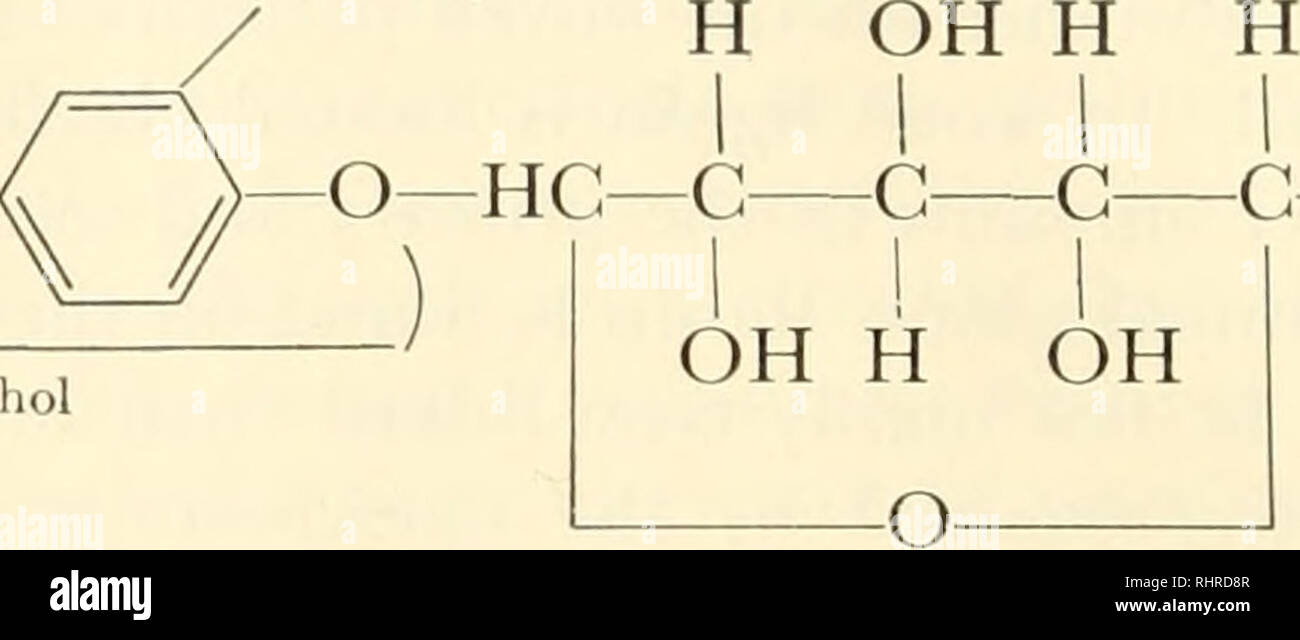. Biochemistry of plants and animals, an introduction. Biochemistry. 188 PLANT BIOCHEMISTRY any of them is lacking. A relationship between coniferin and lignin has been suggested. Coniferin is a glucoside of coniferyl alcohol and is isolated from the cambial sap of the spruce and other conifers. OCH3 HOCH2—CH=CH—('v >—O—HC—C C G C—CH2OH coniferyl alcohol. coniferin The free coniferyl alcohol has also been isolated from the sap of pine species. This phenylpropyl structure has been suggested as the central building unit. However, polymerizations of the above compound cannot account for the hi

Image details
Contributor:
Library Book Collection / Alamy Stock PhotoImage ID:
RHRD8RFile size:
7.2 MB (124.4 KB Compressed download)Releases:
Model - no | Property - noDo I need a release?Dimensions:
2430 x 1029 px | 41.1 x 17.4 cm | 16.2 x 6.9 inches | 150dpiMore information:
This image is a public domain image, which means either that copyright has expired in the image or the copyright holder has waived their copyright. Alamy charges you a fee for access to the high resolution copy of the image.
This image could have imperfections as it’s either historical or reportage.
. Biochemistry of plants and animals, an introduction. Biochemistry. 188 PLANT BIOCHEMISTRY any of them is lacking. A relationship between coniferin and lignin has been suggested. Coniferin is a glucoside of coniferyl alcohol and is isolated from the cambial sap of the spruce and other conifers. OCH3 HOCH2—CH=CH—('v >—O—HC—C C G C—CH2OH coniferyl alcohol. coniferin The free coniferyl alcohol has also been isolated from the sap of pine species. This phenylpropyl structure has been suggested as the central building unit. However, polymerizations of the above compound cannot account for the high degree of cross-linking in lignin and the stability to hydriodic acid. Involvement of such a unit does account for the high vanillin yields on mild oxidation and for the compounds isolated on alkali fusion. RESERVE MATERIALS Once formed, the structural materials discussed in the preceding sec- tion are quite inert when considered from the metabolic standpoint. Plants produce carbohydrates, lipides, or proteins which serve as reserves during periods of energy surplus. Since plants, unlike animals, provide their own food by way of the photosynthetic process, these reserves are stored (1) in the active cell in amyloplasts, oil vacuoles, (2) in special storage organs for the purpose of providing new vegeta- tive growth, or (3) in the seed. Carbohydrates S/arc/i. The most abundant reserve carbohydrate in the plant world is starch. Under favorable conditions it may be found in all the cells of the living plant, usually in grains or granules. The two components of starch, amylose and amylopectin (Chapter 3), vary in proportion in different plants. Some plants produce predominantly amylose; others accumulate a starch which is almost pure amylopectin. Table 8-2 lists the average distribution of the two components in some com- mon starches. It will be noted from the table that not only does the percentage distribution of the two components vary, but so does the size of the